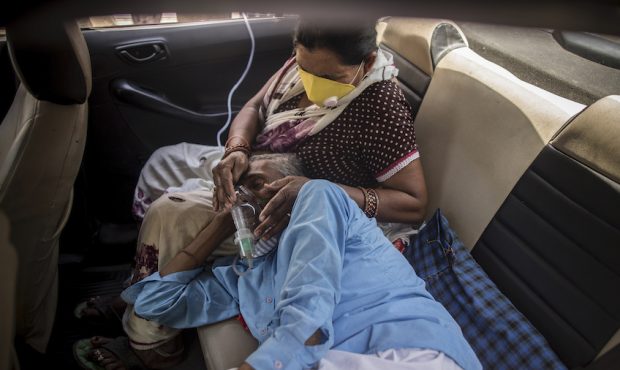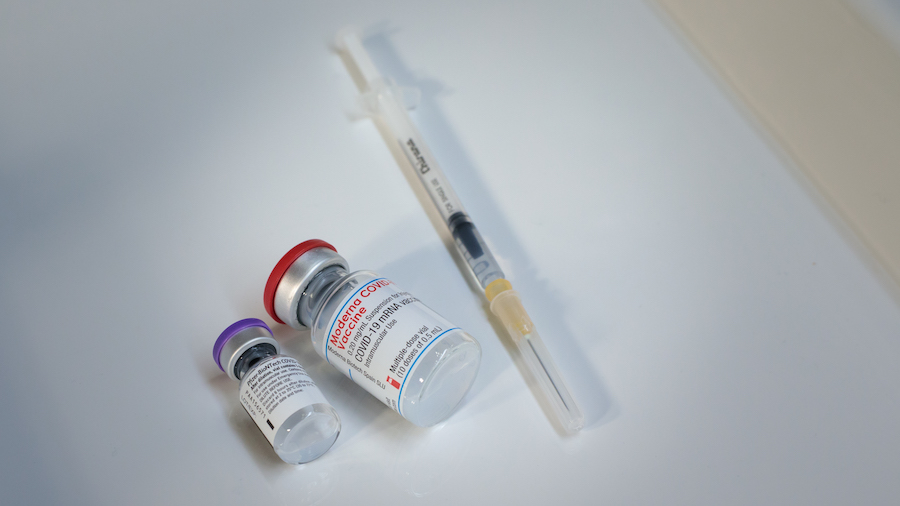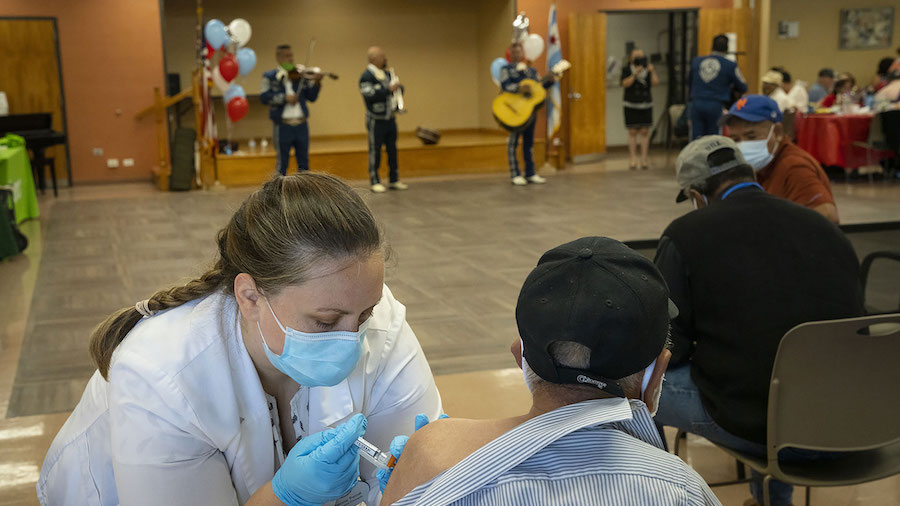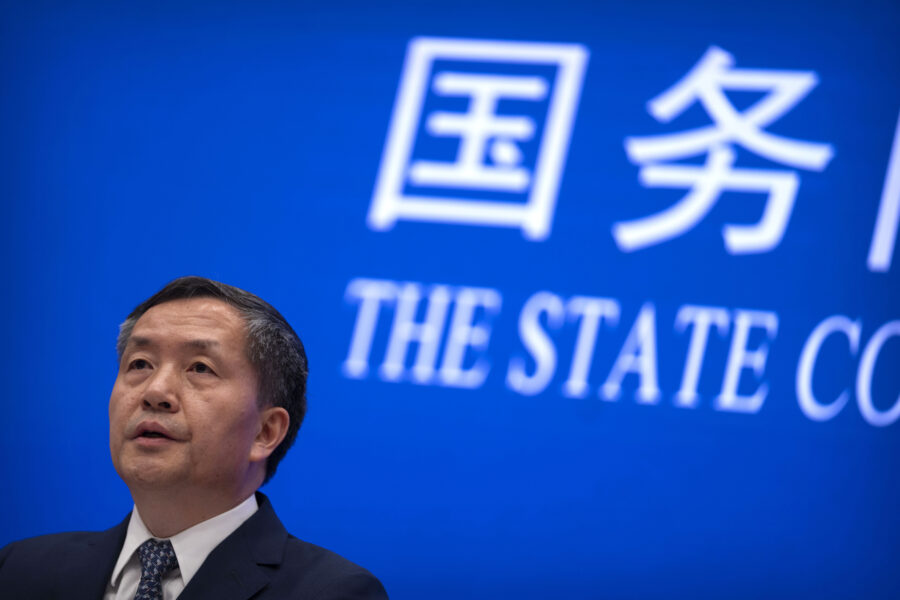CORONAVIRUS
India Virus Patients Suffocate Amid Oxygen Shortage In Surge
Apr 24, 2021, 10:27 AM

Patients who are infected with COVID-19 can be seen wearing oxygen masks as free oxygen was supplied as a part of public service for the people in need by a Gurdwara or a Sikh Holy place amid the rising concerns over lack of oxygen on April 24, 2021, in New Delhi, India. With recorded cases crossing 300,000 a day, India has more than 2 million active cases of COVID-19, the second-highest number in the world after the U.S. A new wave of the pandemic has totally overwhelmed the country's health care services and has caused crematoriums to operate day and night as the number of victims continues to spiral out of control. (Photo by Anindito Mukherjee/Getty Images)
(Photo by Anindito Mukherjee/Getty Images)
SRINAGAR, India (AP) — Indian authorities scrambled Saturday to get oxygen tanks to hospitals where COVID-19 patients were suffocating amid the world’s worst coronavirus surge, as the government came under increasing criticism for what doctors said was its negligence in the face of a foreseeable public health disaster.
For the third day in a row, India set a global daily record of new infections. The 346,786 confirmed cases over the past day brought India’s total to more than 16 million, behind only the United States. The Health Ministry reported another 2,624 deaths in the past 24 hours, pushing India’s COVID-19 fatalities to 189,544. Experts say even those figures are likely an undercount.
The government ramped up its efforts to get medical oxygen to hospitals using special Oxygen Express trains, air force planes and trucks to transport tankers, and took measures to exempt critical oxygen supplies from customs taxes. But the crisis in the country of nearly 1.4 billion people was only deepening as overburdened hospitals shut admissions and ran out of beds and oxygen supplies.
“Every hospital is running out (of oxygen). We are running out,” Dr. Sudhanshu Bankata, executive director of Batra Hospital, a leading hospital in the capital, told New Delhi Television channel.
In a sign of the desperation unfolding over the shortages, a high court in Delhi warned Saturday it would “hang” anyone who tries to obstruct the delivery of emergency oxygen supplies, amid evidence that some local authorities were diverting tanks to hospitals in their areas. The court, which was hearing submissions by a group of hospitals over the oxygen shortages, termed the devastating rise in infections a “tsunami.”
At least 20 COVID-19 patients at the critical care unit of New Delhi’s Jaipur Golden Hospital died overnight as “oxygen pressure was low,” the Indian Express newspaper reported.
“Our supply was delayed by seven-eight hours on Friday night and the stock we received last night is only 40% of the required supply,” the newspaper quoted the hospital’s medical superintendent, Dr. D.K. Baluja, as saying.
On Thursday, 25 COVID-19 patients died at the capital’s Sir Ganga Ram Hospital amid suggestions that low oxygen supplies were to blame.
India’s infection surge, blamed on a highly contagious variant first detected here, came after Prime Minister Narendra Modi declared victory over the coronavirus in January, telling the virtual gathering of the World Economic Forum that India’s success couldn’t be compared with anywhere else.
“In a country which is home to 18% of the world population, that country has saved humanity from a big disaster by containing corona effectively,” Modi said.
But health experts and critics say a downward trend in infections late last year lulled authorities into complacency, as they failed to plug the holes in the ailing health care system that had become evident during the first wave. They also blame politicians and government authorities for allowing super-spreader events, including religious festivals and election rallies, to take place as recently as this month.
“It’s not the virus variants and mutations which are a key cause of the current rise in infections,” Dr. Anant Bhan, a bioethics and global health expert, tweeted this week. “It’s the variants of ineptitude and abdication of public health thinking by our decision makers.”
Dr. Vineeta Bal, who studies immune systems at the Indian Institute of Science Education and Research in Pune city, said that at the heart of India’s “paralyzing” oxygen shortage was the sense of complacency that took hold as cases declined.
When the virus first erupted in India last year, Modi imposed a harsh, nationwide lockdown for months to keep hospitals from being overwhelmed. But the government relaxed restrictions in the face of widespread financial hardship and Modi has refrained from ordering a new lockdown.
But a pandemic doesn’t just end, Bal noted. Summing up the authorities’ response, she said: “Failure of governance, failure of anticipation, failure of planning, compounded by this sense that we’ve conquered (the virus).”
Modi, Home Minister Amit Shah as well as opposition politicians this month took part in mass election rallies in five populous states with tens of thousands of supporters who were not wearing masks or social distancing.
In addition, religious leaders and hundreds of thousands of devout Hindus descended on the banks of the Ganges River in the northern Indian city of Haridwar last month for a major Kumbh festival. Experts have described these as super-spreader events.
“Political and religious leaders have been exemplary on television for not following the restriction that they’re saying ordinary people should follow,” Bal said.
Last week, the Supreme Court told Modi’s government to produce a national plan for the supply of oxygen and essential drugs for the treatment of coronavirus patients.
The government said Saturday it would exempt vaccines, oxygen and other oxygen-related equipment from customs duty for three months, in a bid to boost availability.
In addition, Modi’s emergency assistance fund, dubbed PM CARES, in January allocated some $27 million for setting up 162 oxygen generation plants inside public health facilities in the country. Three months on, only 33 have been created, according to the federal Health Ministry.
But the Defense Ministry is set to fly 23 mobile oxygen generating plants within a week from Germany to be deployed at army-run hospitals catering to COVID patients. Each plant will be able to produce 2,400 liters of oxygen per hour, a government statement said Friday.
That’s coming too late for hospitals in the capital and hard-hit states such as Maharashtra, which have turned to social media to plead with authorities to replenish their oxygen supplies. Early Saturday, Bankata’s Batra hospital reported severe shortage of oxygen for its 190 admitted patients.
When the news anchor asked Bankata what happens when a hospital issues an SOS call as his had done, Bankata replied: “Nothing. It’s over. It’s over.”
Hours later, the hospital received supplies to run for few hours.
Fortis Healthcare, a chain of hospitals across India, said Saturday that one of its hospitals in New Delhi “is running out of oxygen” and was suspending admissions. In a tweet, it said it had been waiting for fresh supplies since the morning.
As the oxygen scarcity deepened, local officials in several states disrupted movement of tankers and diverted supplies to their areas.
On Friday, the Press Trust of India news agency reported that a tanker-truck carrying oxygen supplies in Delhi’s neighboring state of Haryana went missing. Days before, the news agency reported, a minister in Haryana blamed Delhi authorities for looting an oxygen tanker when it was crossing their territory.
“Unfortunately, many such incidents have occurred and have dire effect on hospitals in need of oxygen supplies,” said Saket Tiku, president of the All India Industrial Gases Manufacturers Association.
India is a major vaccine producer, but even after halting large exports of vaccines in March to divert them to domestic use, there are still questions of whether manufactures can produce them fast enough to bring down infections in time in the world’s second most populous country.
India said this week it would soon expand its vaccination program from people aged 45 to include all adults, some 900 million people — well more than the entire population of the entire European Union and United States combined.
___
Associated Press Science Writer Aniruddha Ghosal in New Delhi contributed to this report.












